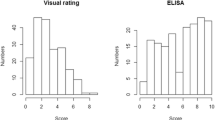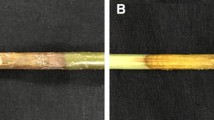Abstract
In recent years, Edwardsiella tarda has become one of the most deadly pathogens of Japanese flounder (Paralichthys olivaceus), causing serious annual losses in commercial production. In contrast to the rapid advances in the aquaculture of P. olivaceus, the study of E. tarda resistance-related markers has lagged behind, hindering the development of a disease-resistant strain. Thus, a marker-trait association analysis was initiated, combining bulked segregant analysis (BSA) and quantitative trait loci (QTL) mapping. Based on 180 microsatellite loci across all chromosomes, 106 individuals from the F1333 (♀: F0768 ×♂: F0915) (Nomenclature rule: F+year+family number) were used to detect simple sequence repeats (SSRs) and QTLs associated with E. tarda resistance. After a genomic scan, three markers (Scaffold 404-21589, Scaffold 404-21594 and Scaffold 270-13812) from the same linkage group (LG)-1 exhibited a significant difference between DNA, pooled/bulked from the resistant and susceptible groups (P <0.001). Therefore, 106 individuals were genotyped using all the SSR markers in LG1 by single marker analysis. Two different analytical models were then employed to detect SSR markers with different levels of significance in LG1, where 17 and 18 SSR markers were identified, respectively. Each model found three resistance-related QTLs by composite interval mapping (CIM). These six QTLs, designated qE1–6, explained 16.0%–89.5% of the phenotypic variance. Two of the QTLs, qE-2 and qE-4, were located at the 66.7 cM region, which was considered a major candidate region for E. tarda resistance. This study will provide valuable data for further investigations of E. tarda resistance genes and facilitate the selective breeding of disease-resistant Japanese flounder in the future.
Similar content being viewed by others
References
Davey J W, Hohenlohe P A, Etter P D, Boone J Q, Catchen J M, Blaxter M L. 2011. Genome-wide genetic marker discovery and genotyping using next-generation sequencing. Nat. Rev. Genet., 12 (7): 499–510.
Fan C X, Chen S L, Wang L, Liu Y, Zhang Y P. 2014. Screening and identification of SSR markers associated with lymphocystis disease resistance in Japanese flounder (Paralichthys olivaceus). J ournal of Fish eries of Chin a, 38 (4): 586–593. (in Chinese with English abstract)
Fuji K, Kobayashi K, Hasegawa O, Coimbra M R M, Sakamoto T, Okamoto N. 2006. Identification of a single major genetic locus controlling the resistance to lymphocystis disease in Japanese flounder (Paralichthys olivaceus). Aquaculture, 254 (1-4): 203–210.
Geldermann H. 1975. Investigations on inheritance of quantitative characters in animals by gene markers I. Methods. Theoretical and Applied Genetics, 46 (7): 319–330.
Goodman R B, Forstrom J W, Osborn S G, Chi E Y, Martin T R. 1991. Identification of two neutrophil chemotactic peptides produced by porcine alveolar macrophages. J. Biol. Chem., 266 (13): 8455–8463.
Gregory H, Young J, Schröder J M, Mrowietz U, Christophers E. 1988. Structure determination of a human lymphocyte derived neutrophil activating peptide (LYNAP). Biochem. Biophys. Res. Commun., 151 (2): 883–890.
Hirschhorn J N, Daly M J. 2005. Genome-wide association studies for common diseases and complex traits. Nat. Rev. Genet., 6 (2): 95–108.
Hoshina T. 1962. On a new bacterium, Paracolobatrum anguillimartiferum n. sp.. Bull. Japan. Soc. Sci. Fish., 28 (2): 162–164.
Houston R D, Haley C S, Hamilton A, Guy D R, Tinch A E, Taggart J B, McAndrew B J, Bishop S C. 2008. Major quantitative trait loci affect resistance to infectious pancreatic necrosis in Atlantic salmon (Salmo salar). Genetics, 178 (2): 1109–1115.
Joyce E A, Popper S J, Falkow S. 2009. Streptococcus pneumoniae nasopharyngeal colonization induces type I interferons and interferon-induced gene expression. BMC Genomics, 10 (1): 404.
Keyvanshokooh S, Pourkazemi M, Kalbassi M R. 2007. The RAPD technique failed to identify sex-specific sequences in beluga (Huso huso). J. Appl. Ichthyol., 23 (1): 1–2.
Lee B Y, Hulata G, Kocher T D. 2004. Two unlinked loci controlling the sex of blue tilapia (Oreochromis aureus). Heredity, 92 (6): 543–549.
Lee E Y, Park H H, Kim Y T, Chung J K, Choi T J. 2001. Cloning and sequence analysis of the interleukin-8 gene from flounder (Paralichthys olivaceous). Gene, 274 (1-2): 237–243.
Liu G Y, Chen K C, Zheng G M, Zhu X P, Zhao J, Xu P, Sun X W. 2011. Screening and identification of female-specific DNA fragments in Channa argus using SSR-BSA. Journal of Fisheries of China, 35 (2): 170–175. (in Chinese with English abstract)
Liu X D, Sui B L, Wang Z Y, Cai M Y. 2013. Screening and verification of microsatellite markers closely related with rapid growth traits in Large Yellow Croaker Larimichthys crocea. Acta Hydrobiologica Sinica, 37 (6): 1036–1043. (in Chinese with English abstract)
Liu Y G, Chen S L, Li B F. 2005. Genetic structure analysis for the cultured stock of Japanese flounder (Paralichthys olivaceus) by microsatellite marker. Marine Fisheries Research, 26(5): 27–33. (in Chinese with English abstract)
Lu Z L, Chi X Y, Wang Y Q, Shen Y B, Zheng Z H, Song S Y. 2007. The screening of microsatellites molecular markers with correlationship to heat-resistance of Paralichthys olivaceus. Journal of Xiamen University (Natural Science), 46 (3): 396–402. (in Chinese with English abstract)
Ma A J, Xu K, Huang Z H, Wang X A. 2011. Screening of microsatellite molecular marker associated with heatresistance of Turbot (Scophthalmus maximus L.). Advance s in Marine Science, 29 (3): 370–378. (in Chinese with English abstract)
Mackay I J, Caligari P D S. 2000. Efficiencies of F 2 and backcross generations for bulked segregant analysis using dominant markers. Crop Sci ence, 40 (3): 626–630.
Matsushima K, Morishita K, Yoshimura T, Lavu S, Kobayashi Y, Lew W, Appella E, Kung H F, Leonard E J, Oppenheim J J. 1988. Molecular cloning of a human monocytederived neutrophil chemotactic factor (MDNCF) and the induction of MDNCF mRNA by interleukin 1 and tumor necrosis factor. J. Exp. Med., 167 (6): 1883–1893.
Mccarthy M I, Abecasis G R, Cardon L R, Goldstein D B, Little J, Ioannidis J P A, Hirschhorn J N. 2008. Genomewide association studies for complex traits: consensus, uncertainty and challenges. Nat. Rev. Genet., 9 (5): 356–369.
Miller M R, Brunelli J P, Wheeler P A, Liu S X, Rexroad III C E, Palti Y, Doe C Q, Thorgaard G H. 2012. A conserved haplotype controls parallel adaptation in geographically distant salmonid populations. Mol. Ecol., 21 (2): 237–249.
Miller M R, Dunham J P, Amores A, Cresko W A, Johnson E A. 2007. Rapid and cost-effective polymorphism identification and genotyping using restriction site associated DNA (RAD) markers. Genome Res earch, 17 (2): 240–248.
Moen T, Baranski M, Sonesson A K, Kjøglum S. 2009. Confirmation and fine-mapping of a major QTL for resistance to infectious pancreatic necrosis in Atlantic salmon (Salmo salar): population-level associations between markers and trait. BMC Genomics, 10 (1): 368.
Nakamura H, Yoshimura K, Jaffe H A, Crystal R G. 1991. Interleukin-8 gene expression in human bronchial epithelial cells. J. Biol. Chem., 266 (29): 19611–19617.
Ozaki A, Okamoto H, Yamada T, Matuyama T, Sakai T, Fuji K, Sakamoto T, Okamoto N, Yoshida K, Hatori K, Araki K, Okauchi M. 2010. Linkage analysis of resistance to Streptococcus iniae infection in Japanese flounder (Paralichthys olivaceus). Aquaculture, 30 (S1): S62–S67.
Shoba D, Manivannan N, Vindhiyavarman P, Nigam S N. 2012. SSR markers associated for late leaf spot disease resistance by bulked segregant analysis in groundnut (Arachis hypogaea L.). Euphytica, 188 (2): 265–272.
Singh S R, Liu W, Hou S X. 2007. The adult Drosophila malpighian tubules are maintained by multipotent stem cells. Cell Stem Cell, 1 (2): 191–203.
Song W T, Pang R Y, Niu Y Z, Gao F T, Zhao Y W, Zhang J, Sun J, Shao C W, Liao X L, Wang L, Tian Y S, Chen S L. 2012. Construction of high-density genetic linkage maps and mapping of growth-related quantitative trail loci in the Japanese flounder (Paralichthys olivaceus). PLoS One, 7 (11): e50404.
Van Ooijen J W. 2006. JoinMap 4.0: software for the calculation of genetic linkage maps in experimental populations. Kyazma BV, Wageningen, Netherlands. 56p.
Wang C M, Lo L C, Feng F, Zhu Z Y, Yue G H. 2008. Identification and verification of QTL associated with growth traits in two genetic backgrounds of Barramundi (Lates calcarifer). Anim Genet., 39 (1): 34–39.
Wang D, Mao H L, Chen H X, Liu H Q, Gui J F. 2009a. Isolation of Y-and X-linked SCAR markers in yellow catfish and application in the production of all-male populations. Anim. Genet., 40 (6): 978–981.
Wang D, Mao H L, Peng J X, Li X Y, Zhou L, Gui J F. 2009b. Discovery of a male-biased mutant family and identification of a male-specific SCAR marker in gynogenetic gibel carp Carassius auratus gibelio. Progress in Natural Science, 19 (11): 1537–1544.
Wang L, Fan C X, Liu Y, et al. 2014. A genome scan for quantitative trait loci associated with Vibrio anguillarum infection resistance in Japanese flounder (Paralichthys olivaceus) by bulked segregant analysis. Mar. Biotechnol., 16 (5): 513–521.
Wang S, Baston C J, Zeng Z B. 2012. Windows QTL cartographer V2.5 011. Department of Statistics, North Carolina State University, Raleigh, NC. 88p.
Xu K, Ma A J, Wang X A, Lei J L, Chen S L, Hou S Y, Huang Z H. 2009. Microsatellites molecular markers and the correlation to growth trait of Scophthalmus maximus. Oceanologia et Limnologia Sinica, 40 (5): 577–583. (in Chinese with English abstract)
Yue G H. 2014. Recent advances of genome mapping and marker-assisted selection in aquaculture. Fish and Fisheries, 15 (3): 376–396.
Zhang Y P, Chen S L, Sun H J, Wang L, Fan C X, Yu Y, Zhang W T, Yang Y M, Zhang Y Z. 2014. Establishment and analysis of Japanese flounder (Paralichthys olivaceus) families with enhanced disease resistance to Edwardsiella tarda. Journal of Fisheries of China, 38 (11): 1917–1925. (in Chinese with English abstract)
Zhang Y Y, Wang W N, Wang J X, Wang A L. 2003. Research on Edwardsiellosis in Japanese flounder. Fisheries Science, 22 (1): 34–36. (in Chinese with English abstract)
Author information
Authors and Affiliations
Corresponding author
Additional information
Supported by the National Natural Science Foundation of China (No. 31461163005) and the Taishan Scholar Project of Shandong Province
Electronic supplementary material
Rights and permissions
About this article
Cite this article
Wang, X., Xu, W., Liu, Y. et al. Quantitative trait loci detection of Edwardsiella tarda resistance in Japanese flounder Paralichthys olivaceus using bulked segregant analysis. Chin. J. Ocean. Limnol. 34, 1297–1308 (2016). https://doi.org/10.1007/s00343-016-5080-7
Received:
Accepted:
Published:
Issue Date:
DOI: https://doi.org/10.1007/s00343-016-5080-7




